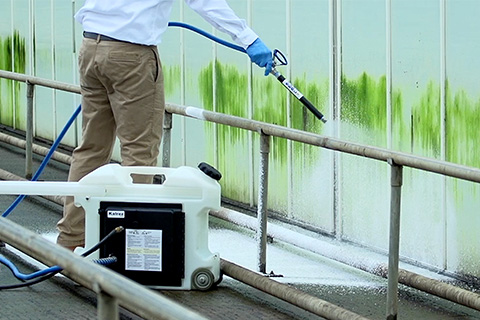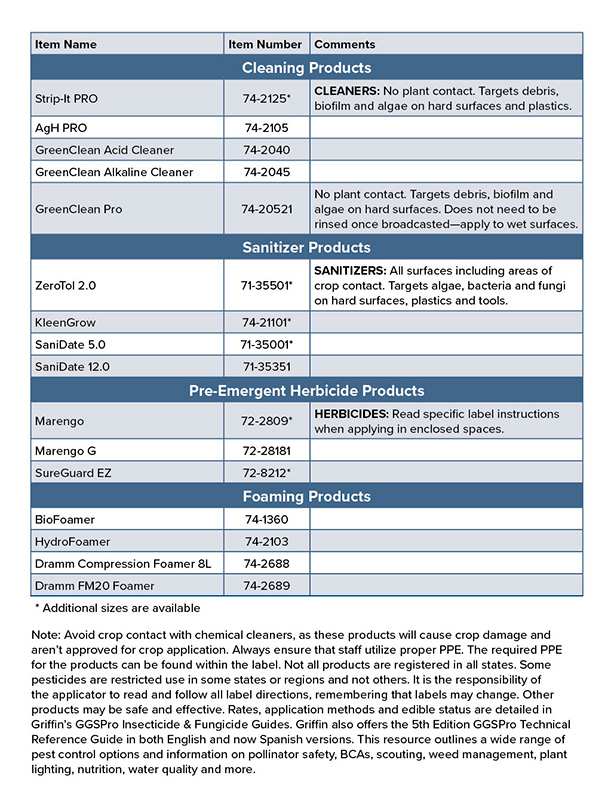6/30/2025
The End of One Season Means Sanitation for the Next
George Grant & Tanner Bailey

When fall season comes to a close and poinsettias go out the door, many growers gear up for young plant production and early spring sales. Regardless of when your doors reopen and plants start filling greenhouse space, it’s imperative to establish and maintain a clean growing environment.
The first step to every successful integrated pest management strategy is to prevent any carryover pests from the previous season or crop cycle. Thus, a comprehensive sanitation procedure is needed to ensure a new crop cycle starts clean.
Physical cleaning
There are three prongs to a successful sanitation program: physical cleaning of the production area, chemical cleaning and disinfecting. The first and most arduous work is the physical cleaning of the production area. In this step, we work through the debris and chaos from the prior season or crop cycle. It should be a “clean sweep” where growers power wash and remove all debris and leftover material (e.g., containers, tags, media, fallen plant material, etc.) from the production area. It’s worth noting that this part is essential for the remaining sanitation steps to be successful.
In almost every case, cleaners should be applied so that contact time is prolonged (i.e., cool and cloudy days). Cleaners, which are generally a combination of strong acids or bases with detergents, should be washed off with clear water before drying or they can leave a considerable residue on hard surfaces. Surfactant or oxidizer-based sanitizers can commonly be left to dry once applied, but it’s important to follow all label instructions to ensure equipment, employee and plant safety.

Foaming is fun
Foaming continues to gain momentum in sanitation practices for several reasons: 1) It allows the applicator to see exactly where they sprayed or are applying (preventing accidental or reapplications); 2) it allows chemicals to fight gravity and stick to vertical surfaces more easily; and 3) it also tends to be more enjoyable than conventional spraying.
Foaming can be achieved by using various pieces of technology—many of our professional cleaners already have detergents in them, making them easy to foam as well. Dramm’s FM20 Foamer is great for foaming large areas quickly with the help of an air compressor.
For spot foaming small areas, Dramm’s Compression Foamer is very similar to using a hand pressurized pump sprayer. If directly injecting from the bottle or injecting from a stock tank, a HydroFoamer is a simplistic cost-effective device where a spray nozzle can be connected to a hose end to automatically produce a foam consistency. BioSafe’s BioFoamer agent can be used in tandem with various foaming equipment to help enhance foam thickness. Foamers can be used to apply both cleaning products and sanitizers.
Keys areas to consider foaming
Contact and coverage are key with both cleaners and sanitizers. Thoroughly apply these to benches, concrete floors, cooling pads, groundcover fabrics and other non-porous surfaces in the production area. For cleaners, allow a minimum of three- to five-minute treatment time and follow up with a clean water wash-down.
If you’re using a fan-and-pad evaporative cooling system, you know how fouled evaporative cooling pads get unless proper maintenance is implemented. Remember, wherever there’s water, biofilm and algae can follow. Couple this with mineral scale, which is very common for high alkalinity irrigation sources and we can quickly reduce the efficacy of our equipment.
Similar to other surfaces and irrigation lines, we need to rely on a strong acid-based cleaner to help physically remove or dissolve this combination of contaminants that’s developed. Foaming is a great way to ensure the cleaner or sanitizer being applied has longer contact time on vertical surfaces.
Underneath benches where there’s excessive buildup of algae, soil media or gravel is also another area that growers forget to sanitize, but they’re a haven for carrying over issues. Clean and rinse out irrigation lines first before going back in with foaming floor surfaces. Rinse the cleaning solution down once a thick layer of foam has had adequate contact time to clean these production spaces.
Herbicide applications and disinfecting after cleaning
Once the greenhouse has been physically and chemically cleaned, applying an appropriately labeled herbicide for post- and pre-emergent (e.g., Marengo or SureGuard EZ) weed control is recommended. (Contact GGSPro for a full list of herbicides labeled for greenhouse use—the appropriate product can depend on your needs and situation.)
The final step of applying a sanitizing agent to hard surfaces such as benches, sidewalls and irrigation lines will ensure thorough disinfection. ZeroTol 2.0, SaniDate 5.0, SaniDate 12.0 or KleenGrow can be used as effective choices. These products are applied and left to air-dry on the treated surfaces, leaving behind no chemical residues. Please reach out to your local Griffin sales representative or GGSPro for specific usage rates. GT
George Grant, Ph.D., is GGSPro Technical Services Manager. Tanner Bailey is a GGSPro Technical Specialist.